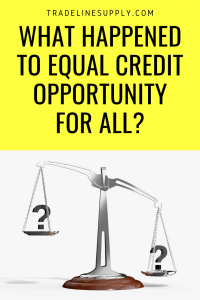What Happened to Equal Credit Opportunity for All?

Buying Tradelines: How Many Tradelines Do I Need?
03/05/2021
The Top 3 Credit Myths That Won’t Go Away
05/04/2021
Equality, fairness, and justice are all concepts that the United States promotes as some of its highest values.
In reality, the history of our country and society has not always lived up to those values. In fact, our history has proven to be so far from those ideals that we do not even need to mention how far off our society has been in our not-so-distant past.
Fast forward to now, and many people may believe that our country has worked out all those unfair and unequal practices. But the truth is that in our capitalist society, powerful private institutions provide the backbone of our economy, and the facts paint an interesting picture of how our financial systems really operate.
Do Credit Scores Actually Work?
For decades, lenders have been relying on automated underwriting tools that are largely or entirely based on the contents of one’s credit report. Do these tools succeed at their goal of accurately determining the creditworthiness of consumers?
What Do Credit Scores Do?
A credit score is a number that is supposed to symbolize the credit risk of a consumer. The scale usually ranges from 300 to 850, with lower scores indicating that you have a high risk of defaulting on a loan and higher scores indicating that you have a low risk of defaulting. Generally, credit scores that fall below 579 are considered bad credit, while scores that exceed 670 are considered good credit, and 850 is a perfect credit score.
Each type of credit score, such as a FICO Score or a VantageScore, has a different mathematical formula that uses the data in your credit report to produce your score, which represents the statistical likelihood of you defaulting in the future. The specifics of the credit scoring algorithms are trade secrets, so not all of the information about how exactly they work is available to the public.
Credit Scoring Models Are Flawed
It is estimated that one-fifth of consumers have at least one error on their credit report that has the potential to make them look riskier than they are, which could result in higher interest rates, less favorable loan terms, or being denied credit. In other words, millions of people are potentially being negatively affected by inaccurate information on their credit reports.
Furthermore, it is well-known that in our credit system, consumers are rewarded for having debt and penalized for paying in cash, because taking on debt is one of the primary ways of establishing a payment history. You would think that being burdened with more debt would make you a higher credit risk, yet credit scoring models are designed to reward this behavior.
For example, many consumers are unpleasantly surprised to find out that sometimes paying off a loan can actually hurt your credit score. This is counterintuitive because it would seem that your credit risk has decreased now that you no longer have to make payments that loan, and therefore it would make sense for your credit score to go up as a result.
However, that is not how credit scores work. Here’s what really happens in this scenario: the action of paying off the loan would close the account and remove it from your mix of credit, which could have a negative effect on your score.
Clark Abrahams, Chief Financial Architect of SAS Institute, said it well in his testimony before the House Financial Services Committee, asking, “Are we to tell consumers that being responsible in their financial affairs means that they need to modify their behavior so as to maximize their credit score?”
The goal of a credit score is to indicate who is creditworthy and who is not, which should depend on an individual’s ability and willingness to repay an obligation. Yet this quality is not always reflected in one’s credit score. Instead, credit scores are based exclusively on what is and is not in one’s credit file, which often doesn’t tell the whole story.
Is the Credit Scoring System Fair and Equitable?

Just a few years ago, it was revealed that two of the three major credit-reporting agencies that control credit scores—Equifax and Transunion—had been deceiving and taking advantage of consumers.
If you’re familiar with the credit system, it’s not exactly shocking that the credit bureaus have been abusing their power. This is just one example of the dysfunction that runs deep in the credit system and causes widespread harm to consumers.
The Equal Credit Opportunity Act of 1974 was enacted in an effort to prevent discrimination in lending. In the 1970s, people started to pay attention to credit discrimination against consumers based on age, race, gender, and other factors. In 1972, the National Commission on Consumer Finance revealed that there was widespread discrimination against women in the credit industry. A congressional report identified 13 discriminatory practices used specifically against women.
These discoveries led to the Equal Credit Opportunity Act (ECOA), which prohibits lenders from discriminating against any applicant on the basis of age, gender, ethnicity, nationality, or marital status. Regulation B of ECOA prohibits creditors from requesting information about certain characteristics to prevent lenders from making decisions based on prejudicial assumptions.
Officially, credit discrimination is prohibited. But it is not clear whether ECOA has succeeded in its goal, and many questions remain as to whether there is still inequality in the credit industry.
Is ECOA enforced effectively, or does discrimination still happen? Does the credit scoring system affect population groups differently? Do the factors used in calculating credit scores affect certain individuals grouped by race, gender, age, or other protected characteristics?
Unfortunately, the language of ECOA makes it virtually impossible for those who believe they have been discriminated against to win a lawsuit against a creditor, and the governing federal agencies have not picked up the slack in enforcing ECOA. There is no shortage of data showing that there is disparate treatment of certain groups when it comes to credit scoring.
This is because the credit scoring system not only reflects but perpetuates the economic inequalities in this country.
Who Are Credit Invisibles?
According to the Consumer Financial Protection Bureau (CFPB), about one out of five adults in the United States are “credit invisible,” meaning they are unscoreable by traditional credit scoring methods and traditional credit data.
The lack of a conventional credit record prevents these consumers from obtaining the financial products and services they need to be successful since they are seen by lenders as too high of a credit risk.
A report by the Policy and Economic Research Council (PERC) on credit invisibility in Silicon Valley showed that unscoreability is a big problem in low-income areas. However, low-income does not necessarily equate to financially irresponsible.
We can see evidence of this in a study by PERC and the Brookings Institution Urban Markets Initiative, which shows that when alternative data (such as rent and utility payment history) are used in credit ratings, those lacking a traditional credit history have similar risk profiles as those in the credit mainstream. This suggests that most credit invisible consumers may not represent as high of a risk to lenders as is often assumed.
On the other hand, some of these consumers do have relatively good incomes but are credit invisible for various reasons, such as a preference to use alternative financial technology services instead of traditional financial institutions, a decision to be voluntarily credit-inactive and debt-free, or a cash-based lifestyle due to lack of access to banking services (as in some immigrant populations).
You can read more about this issue in our article, “What Does It Mean to Be Credit Invisible?”
Credit Scores and Income

Low-income consumers are about 8 times more likely than high-income consumers to lack credit records that are scoreable by widely used credit scoring models.
In consumers that do have credit scores, individuals who reside in low-income census tracts have lower credit scores than other income groups, according to the CFPB.
They also found that people in lower-income neighborhoods are less than half as likely as those in upper-income neighborhoods to gain a credit record by relying on the good credit of others (such as through joint accounts or authorized user accounts) and are 240 percent more likely to become credit visible due to negative records.
Lower-income consumers are less likely to have one or more AU tradelines, and those that do acquire shorter credit histories from the accounts than those in higher-income areas.
Even after controlling for credit scores, consumers in low-income areas face higher denial rates than other groups.
How the Credit System Adversely Affects Some Races and Ethnicities
In a report to Congress on credit scoring and its effects on the availability and affordability of credit, the Federal Reserve Board raised concerns that factors in credit scoring models could adversely affect consumers based on their race or ethnicity.
The study determined that on average, Black and Hispanic consumers had lower credit scores than non-Hispanic White and Asian consumers, and a gap remained even when controlling for differences in personal demographic characteristics, location, and income.
In addition, when looking at the same credit score for all groups, outcomes such as loan performance, credit availability, and credit affordability differed between these groups.
For example, it seems that Black individuals pay higher interest rates on auto and installment loans than do non-Hispanic White consumers with the same credit score. In addition, Black and Hispanic consumers experience higher denial rates than other groups with the same score.
When it comes to credit piggybacking, another analysis by the Federal Reserve Board on how authorized user tradelines are treated by credit scoring models revealed that AU tradelines were most common among non-Hispanic White consumers and least common among Black consumers.
Credit Scoring Discriminates by Age

Younger individuals tend to have lower credit scores, which makes a lot of sense considering that one of the main factors in credit scoring is the length of your credit history, which is also referred to as your credit age.
Unfortunately, this means that young people who may be creditworthy are at a disadvantage simply by virtue of not being old enough to have a very long credit history. Younger consumers also experience relatively high denial rates compared to other demographics.
Other Groups Marginalized by Credit Rating
The unequal effects of credit scoring are not limited to the above groups. It can affect consumers in surprising ways. For example, recent immigrants have lower credit scores than their performance would predict.
Credit invisibility is more prevalent in areas with less digital access to traditional financial service providers, such as in rural areas.
And since no federal law protects LGBTQ people from discrimination, they may still be denied credit with no option for recourse.
Why the Credit System Is Inherently Discriminatory
In the Federal Reserve Board’s report to Congress, they listed the “five C’s,” which are factors that seem to influence the variations in credit performance with race, age, gender, national origin, etc. The five C’s are:
- Capacity: income available to pay off debts
- Collateral: the value of assets backing a loan
- Capital: the value of assets that do not explicitly back a loan but may be available to repay it
- Conditions: events that can disrupt income generation or create unexpected expenses that affect a borrower’s ability to make loan payments
- Character: the financial skills, experience, and/or willingness of a borrower that pertain to their ability to manage financial obligations
The way credit scores are determined privileges those who already have wealth, high incomes, education, and a support system of people who can help them out in a financial crisis.
In contrast, historical discrimination against minorities in the United States continues to affect each of the five C’s in ways that have serious and persistent consequences on credit scores.
In relying on and reflecting past inequality, credit scores also perpetuate that inequality.
According to the National Consumer Law Center, communities of color have less income and far less wealth than white Americans, thanks to centuries of discrimination and exclusion. Redlining, segregation in education, implicit bias in employment, and mass incarceration have prevented communities of color from attaining higher incomes and accumulating wealth.
The racial wealth gap makes it exponentially more difficult to recover from emergencies or financial setbacks. These inequalities take a toll on each of the 5 C’s, which in turn contributes to the higher proportion of credit invisibility and poor credit in minority communities.
Since credit scores are used in decisions that affect housing, insurance, employment, loans, and more, poor credit scores mean consumers of color are disproportionately denied credit, affordable housing, jobs, and other basic necessities.
Even when some credit products are attainable, steep interest rates and fees deplete capital and make loans much more difficult to repay, which continues the cycle of bad credit.
The system further burdens those who are already financially strained and provides very few opportunities to improve their situation.
Can We Fix Credit Scoring?
The credit scoring industry clearly has a multitude of problems. It’s no surprise that an inherently discriminatory system meant to serve for-profit companies has not produced equitable results.
Some believe that private companies shouldn’t even be the parties responsible for calculating credit scores. These for-profit corporations harvest our information, use closely-guarded proprietary algorithms to calculate credit scores, and sell this information to other companies in the financial sector.
Their clients are lenders, not consumers, so they do not have an incentive to fairly and accurately represent consumers. Perhaps a system in which this task falls to public institutions would be more accountable to consumers.
Alternative Credit Data
Sources that determine loan worthiness are diversifying—notably for credit cards and auto loans.
A U.S. Government Accountability Office report from 2022 indicates the door to alternative credit data is opening.
“But more and more lenders are turning to alternative data to determine loan eligibility. Alternative data is information not used in traditional credit reporting and can be financial or nonfinancial in nature. It can include information like your bank account transactions; your on-time rental, utility, or telecommunications payments data (traditional credit reports typically include only late payments); and the educational institution you attended and degree you earned.”
Credit Scoring Alternatives for Those Without Credit
However, most lenders still use FICO 8, which is over 10 years old, so it would likely take a long time before scores that draw on more diverse data are widely deployed.
Civil rights and consumer advocacy groups argue that the addition of alternative data would actually “reduce consumers’ control over their own data by preempting state and federal privacy protections [and] damage the credit scores of millions of consumers with a disproportionate impact on African Americans.”
For every consumer who chooses a financial account, it is important to clarify if information will or will not be shared with the credit bureaus. Many financial accounts continue to remain unreported to the major credit bureaus.
Perhaps what we really need is a broader conversation about how we judge creditworthiness and how we can create new tools that account for discrimination to create a more equal and just playing field. We need to question the assumption that past events represent a true reflection of someone’s current creditworthiness.
While the industry may be (very) slowly changing for the better, unfortunately, the faulty credit scoring system we have now will continue to negatively impact the lives of millions of people for years to come. That’s why we are driven to help provide solutions and opportunities to disadvantaged consumers.
How Do Tradelines Fit Into Equal Credit Opportunity?
Having good credit often comes down to having a good start in life and knowing how to play the credit game. Some people are born with access to wealth and education while others are not. People who don’t have the resources to start building good credit early on often get stuck in the downward spiral of a broken system that leaves them with little to no room to improve their financial situation.
When people make mistakes, as we all do sometimes, these mistakes have a much greater impact on those who lack good credit than those who have been playing the credit game for years.
The gap between classes in society is getting larger, as opposed to our country’s ideal of promoting equality. In reality, the wealthy are the ones who receive the most help and opportunities.
Our society has become a credit-based society in which credit scores affect almost every aspect of our lives, yet there are clear “winners” and “losers” in our credit scoring system. Statistically, there are clear indications that these differences are not spread out equally across our country.
Good credit is something that many privileged Americans start out with early in adulthood because of the family they were born into. This is no secret among the wealthy.
On the other end of the spectrum, many lower-income families do not have family members with good credit that they can ask to help them build credit by adding them as an authorized user on a credit card. This option simply does not exist to many, while the banks encourage it for others.
To us, it does not seem fair that some people have this option but others do not. Tradeline Supply Company, LLC seeks to bridge this gap by helping to provide a chance at equal credit opportunity for all.
What do you think about the credit system and equal credit opportunity? If you liked this article, please share it or leave us a comment below!





19 Comments
This is Awesome Articale with Real Truth
Keep Exposing the Industry Smash the Stereo Types this is why I started My Company
Thanks, Damien!
If the trade line is not on the credit within the 7 days promise what’s next
It seems like you are confused about our guarantees. We do not have a 7-day promise. Read them here.
https://tradelinesupply.com/guarantees/
Wow! Very great information here. This opened my eyes a little bit more.
Thank you Kerrie!
I just want to say, thank you for sharing this true and accurate data. I am 100% interested in learning how to use tradelines and becoming a broker with your company.
Thank you, Kimmie! Go to our Brokers page and enter your contact information to register as a broker with us!
https://tradelinesupply.com/affiliates/
Well explained
Thank you for reading!
This is an amazing article because it speak the truth about a society that maliciously takes advantage of low-income families and communities. I love it. Thank you for writing this article and really putting it out there.
Thank you so much for your comment! We’re glad this article resonates with you.
Thank you, for writing the truth every one should be Free from Financial Bondage
WOW! and we are a Credit Serving Company jumping through hoops to help people turn their credit around. This article is EXCELLENT!!!! And yes we see this through our own reports and averages how this lopsided system is unfair to many people.
We’re glad you like the article! Thanks for reading!
Wow deeply honored considering I’m one of the racists people of color your talking about helping me to understand why I try so hard to keep trying to build my credit up and still one if my scores are still at 460
I think the issue is the level of intelligence that are individually hired buy creditors. And the 3 bureau’s. I’ve had success and failures. Things like child support placing two accounts on my report for on child. As well as them failing the act update disputes for student loan consolidation. I don’t even have loans with the company that is reporting that I do they allow any company to report false claims. This is the problem for me. And the only problem if not for The three things I just mentioned. I would have perfect credit and the entire world would benefit. What is a person supposed two do when the minds of stupidity have jobs they are not supposed to have.
DOT number
EIN number As well, this is my personal credit trying to get ahead in life start my business and I’m also retired
Looking forward to talking this specialist
Hello, please call us at 619-255-9588 if you have questions about our tradelines. Thank you!